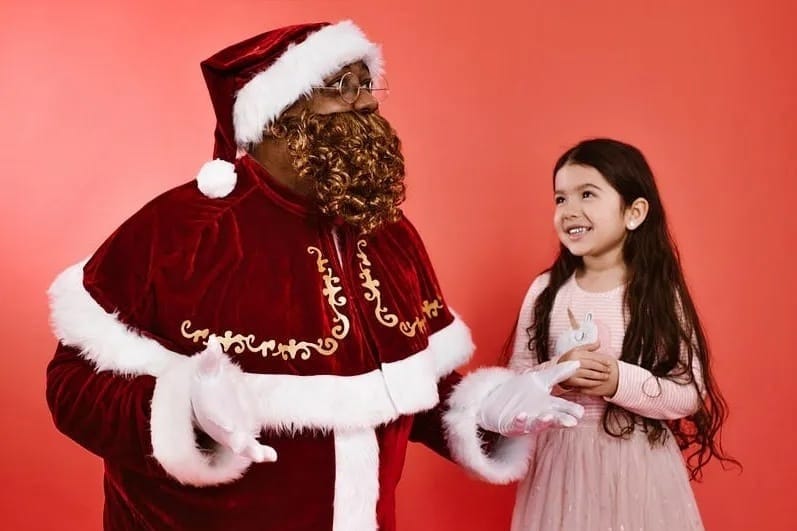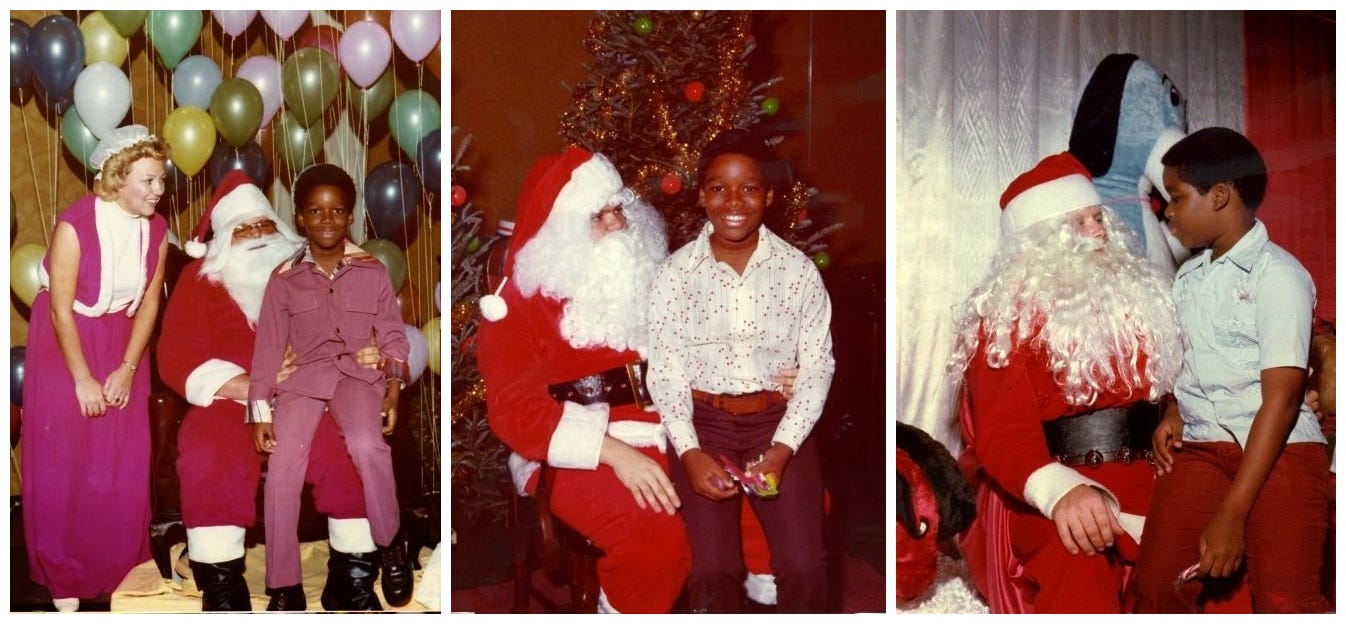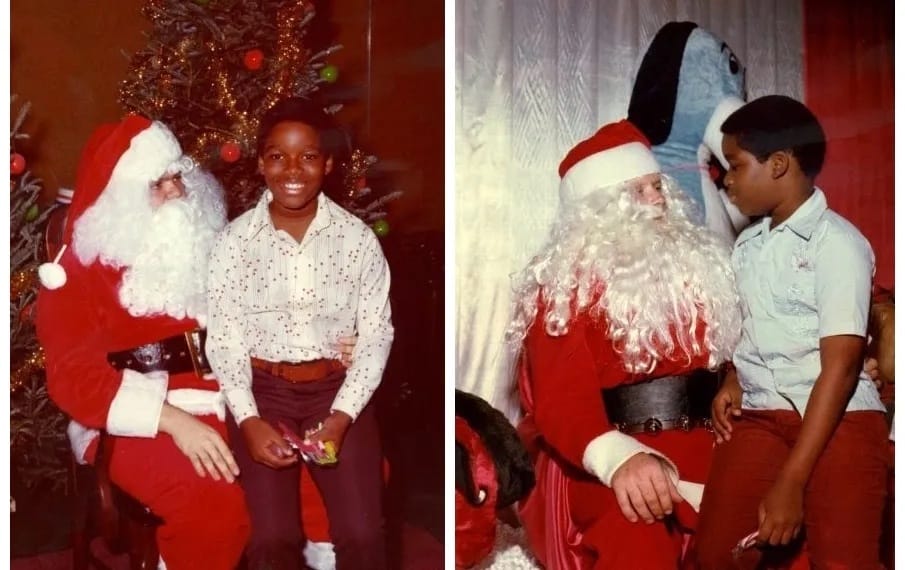Santa Claus and I have a weird history. I’m not sure I ever actually believed in Kris Kringle, but he didn’t need to be real to leave me feeling some kind of way.
As a kid, I spent a bit of time on the laps of White men who were pretending to be him, and although I usually smiled for the camera, I was never altogether comfortable sitting there. When I look at pics of me with those White Santas, I often wonder what they were thinking about the chubby little Black boy perched on their lap.
A lifetime of racism has ruined a lot of things for me, including my early memories of those real-life Santas. I now reconsider them through the prism of my grown-up racial awareness. Kissimmee, Florida, was not a bastion of racial harmony in the ’70s, and it’s not a given that race ceased to matter when those White men put on the Santa suit. Despite Megyn Kelly’s insistence that Santa Claus was a White man, a few Black Santas might have made all the difference in the world to me then — and probably would now, too.
Even without race coloring my view of Santa as a child, I still was somewhat unsettled by the way he was portrayed both in the media and by real-life men. He was my version of the clown, a symbol of fun and jolly that kind of scared the shit out of me.

Maybe it was the way he looked. His big, ruddy white face was so covered up by white whiskers and a floppy red and white hat that pretty much the only thing you could see were red, white, and his eyes. I remember sitting on the lap of the guys who’d dress up as Santa at my mom’s annual company Christmas parties, wondering who was behind all the fakery.
I’d always been told to steer clear of stranger danger, but there I was, plopped on some strange lap, and everyone around me was smiling about it. I didn’t even know what he really looked like. My mother didn’t seem to have a problem with it, but I couldn’t imagine any other circumstance in which she would have given her blessing to such an awkward arrangement. I guess, in a way, Santa was my first silver daddy.

It’s a good thing he’s an old guy. I can’t imagine a young, hot Santa getting away with being a breaking-and-entering voyeur, someone who “knows when you are sleeping” and “knows when you’re awake.” I’m convinced he’d be arrested on the spot for climbing down little kids’ chimneys in the middle of the night while they’re sleeping.
According to the old 1970 Rankin-Bass special Santa Claus Is Comin’ to Town, that’s precisely why he started breaking and entering from above — to avoid detainment. I probably watched the animated retelling of Santa’s origin story every Christmas for the first 13 or so years of my life, but when I screened it this year, in some ways, it was almost like I was seeing it for the first time.
Growing up, I was always especially terrified by Burgermeister Meisterburger, the ruler of Sombertown who banned toys from his kingdom. He was like the villain of a Biblical epic (the story of Moses or Christ — take your pick), punishing little kids out of fear and loathing. His rotund face was my personal nightmare before Christmas.
This year, though, for the first time, I realized how un-scary Burgermeister Meisterburger actually is. In fact, like so many Disney Villains now do (Captain Hook in Peter Pan, Ursula in The Little Mermaid, Hades in Hercules — take your pick), he set off my gaydar. All that drama. All that scenery-chewing.
It was like I was seeing Santa for the first time, too, particularly during the part where young, ginger Santa starts singing a song called “If You Sit on My Lap Today.” Sample lyrics:
If you sit on my lap today
A kiss a toy is the price you’ll pay
When you tell what you wish for —
In a whisper
Be prepared to pay
And they called Joe Biden creepy for his overly tactile ways? What about young, ginger Santa?
I can understand why no-one batted an eye in 1970. Back then, we hadn’t yet begun assigning double meanings to pretty much everything.
In a post-Michael Jackson world, though, how does this keep getting past the censors and the PC brigade? A couple of years ago, everyone was outraged over the scene in A Charlie Brown Thanksgiving where Franklin, the lone Black Peanuts character, sits alone on one side of the dinner table in a rickety old chair. To me, that was nothing. But I can’t believe nobody seems to have a problem with young Santa demanding a kiss on the cheek for a toy.
It’s not a particularly good Santa look, and I have a feeling that song would not be included if Santa Claus Is Comin’ to Town were being remade now. These days, we tend to prefer it when St. Nick/Kris Kringle is irreverent and un-PC in a different way — see the Bad Santa movies and Kurt Russell’s rock & roll silver fox of a Santa in Netflix’s Christmas Chronicles movies. I wonder if my discomfort with all those White Santas from my childhood would have been different if I’d grown up with the modern ones instead.
Who knows? It’s too late to find out now. This, however, I do know for certain: Mommy can kiss Santa Claus until the mistletoe drops, but little kids shouldn’t have to pucker up for gifts. I’ll never listen to “Santa Claus Is Comin’ to Town” the same way again.
This post originally appeared on Medium and is edited and republished with author's permission. Read more of Jeremy Heligar's work on Medium.

